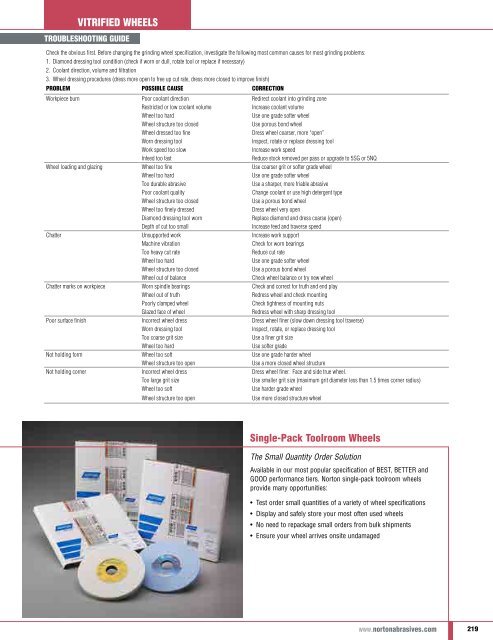You also want an ePaper? Increase the reach of your titles
YUMPU automatically turns print PDFs into web optimized ePapers that Google loves.
Vitrified Wheels<br />
Troubleshooting Guide<br />
Check the obvious first. Before changing the grinding wheel specification, investigate the following most common causes for most grinding problems:<br />
1. Diamond dressing tool condition (check if worn or dull, rotate tool or replace if necessary)<br />
2. Coolant direction, volume and filtration<br />
3. Wheel dressing procedures (dress more open to free up cut rate, dress more closed to improve finish)<br />
Problem Possible Cause Correction<br />
Workpiece burn Poor coolant direction Redirect coolant into grinding zone<br />
Restricted or low coolant volume<br />
Increase coolant volume<br />
Wheel too hard<br />
Use one grade softer wheel<br />
Wheel structure too closed<br />
Use porous bond wheel<br />
Wheel dressed too fine<br />
Dress wheel coarser, more “open”<br />
Worn dressing tool<br />
Inspect, rotate or replace dressing tool<br />
Work speed too slow<br />
Increase work speed<br />
Infeed too fast<br />
Reduce stock removed per pass or upgrade to 5SG or 5NQ<br />
Wheel loading and glazing Wheel too fine Use coarser grit or softer grade wheel<br />
Wheel too hard<br />
Use one grade softer wheel<br />
Too durable abrasive<br />
Use a sharper, more friable abrasive<br />
Poor coolant quality<br />
Change coolant or use high detergent type<br />
Wheel structure too closed<br />
Use a porous bond wheel<br />
Wheel too finely dressed<br />
Dress wheel very open<br />
Diamond dressing tool worn<br />
Replace diamond and dress coarse (open)<br />
Depth of cut too small<br />
Increase feed and traverse speed<br />
Chatter Unsupported work Increase work support<br />
Machine vibration<br />
Check for worn bearings<br />
Too heavy cut rate<br />
Reduce cut rate<br />
Wheel too hard<br />
Use one grade softer wheel<br />
Wheel structure too closed<br />
Use a porous bond wheel<br />
Wheel out of balance<br />
Check wheel balance or try new wheel<br />
Chatter marks on workpiece Worn spindle bearings Check and correct for truth and end play<br />
Wheel out of truth<br />
Redress wheel and check mounting<br />
Poorly clamped wheel<br />
Check tightness of mounting nuts<br />
Glazed face of wheel<br />
Redress wheel with sharp dressing tool<br />
Poor surface finish Incorrect wheel dress Dress wheel finer (slow down dressing tool traverse)<br />
Worn dressing tool<br />
Inspect, rotate, or replace dressing tool<br />
Too coarse grit size<br />
Use a finer grit size<br />
Wheel too hard<br />
Use softer grade<br />
Not holding form Wheel too soft Use one grade harder wheel<br />
Wheel structure too open<br />
Use a more closed wheel structure<br />
Not holding corner Incorrect wheel dress Dress wheel finer. Face and side true wheel.<br />
Too large grit size<br />
Use smaller grit size (maximum grit diameter less than 1.5 times corner radius)<br />
Wheel too soft<br />
Use harder grade wheel<br />
Wheel structure too open<br />
Use more closed structure wheel<br />
Single-Pack Toolroom Wheels<br />
The Small Quantity Order Solution<br />
Available in our most popular specification of BEST, BETTER and<br />
GOOD performance tiers. <strong>Norton</strong> single-pack toolroom wheels<br />
provide many opportunities:<br />
• Test order small quantities of a variety of wheel specifications<br />
• Display and safely store your most often used wheels<br />
• No need to repackage small orders from bulk shipments<br />
• Ensure your wheel arrives onsite undamaged<br />
www.nortonabrasives.com<br />
219

















